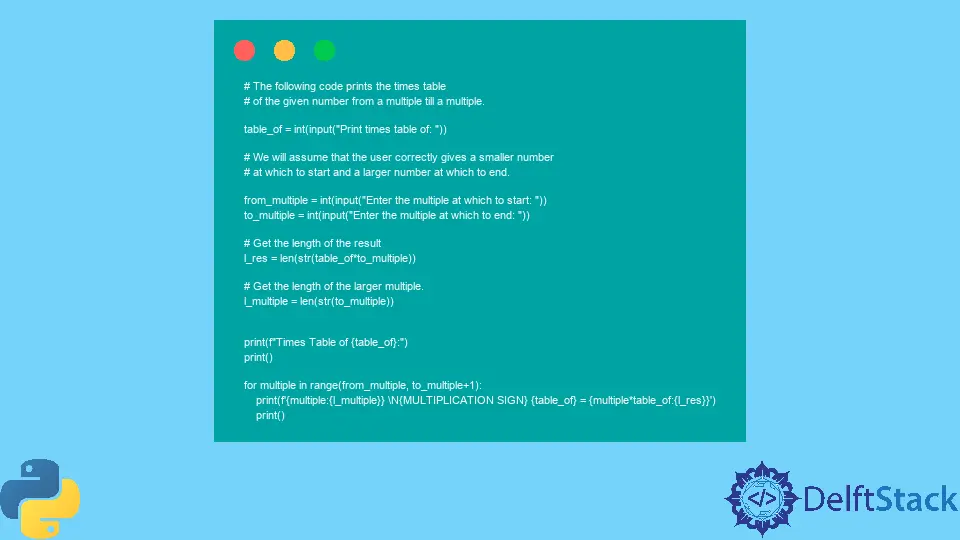使用基本程式設計概念在 Python 中列印乘法表
Jesse John
2023年1月30日
Python
Python Math

我們可以通過學習在 Python 中列印時間表來練習幾個基本的程式設計概念。這些包括:
- 使用變數
- 獲取使用者輸入
- 使用內建函式
- 型別轉換變數
- 迭代(迴圈)
- 字串格式化
- 使用 Unicode 符號
我們將使用 Python 的 f 字串格式化功能,可用於 Python 3.6 及更高版本。
基本程式設計概念
我們可以宣告一個變數併為其賦值,如下所示。
table_of = 5
我們將使用 input() 函式來獲取使用者輸入,如下所示。
table_of = input("Print times table of: ")
程式將顯示字串 Print times table of: 並等待使用者輸入。使用者可以輸入任何內容。Python 將輸入解釋為字串。
要將其轉換為整數,我們將在 input() 函式週圍使用 int() 函式。
table_of = int(input("Print times table of: "))
print("Times") 在顯示屏上列印單詞 Times。一個空的 print() 函式列印一個空行。
range() 函式建立從 start_int 到但不包括 end_int 的序列。預設情況下,它增加 1。
range(start_int, end_int, step_int)
我們將在程式碼中使用 for 迴圈。只要變數在指定範圍內,它就會重複迴圈中的程式碼多次。
for variable in range(start, end):
code to repeat
Python 的 f 字串格式化功能允許我們使用佔位符 {} 在字串中包含變數。要使用變數 table_of 的值,我們將使用:
print(f"Times table of {table_of}")
我們可以使用整數指定佔位符的長度。在程式碼中,我們使用另一個變數來指定這一點:結果 table_of * 9 的長度。
我們使用 str() 將整數轉換為字串以獲得長度。
乘法符號使用其 Unicode 名稱指定。
\N{MULTIPLICATION SIGN}
在 Python 中列印給定數字的時間表
我們現在將把上述所有概念放在下面的程式碼中。它將以兩種方式列印使用者給定數字的乘法表。
示例程式碼:
# The following code prints the times table
# of the given number till 'number x 9'.
# It prints the times table in two different ways.
table_of = int(input("Print times table of: "))
# Get the length of the result
l_res = len(str(table_of * 9))
print(f"Times Table of {table_of}:")
print()
for multiple in range(1, 10):
print(
f"{multiple} \N{MULTIPLICATION SIGN} {table_of} = {table_of*multiple:{l_res}}"
)
print()
print("-------------")
print()
for multiple in range(1, 10):
print(
f"{table_of} \N{MULTIPLICATION SIGN} {multiple} = {table_of*multiple:{l_res}}"
)
print()
樣本輸出:
Print times table of: 1717
Times Table of 1717:
1 × 1717 = 1717
2 × 1717 = 3434
3 × 1717 = 5151
4 × 1717 = 6868
5 × 1717 = 8585
6 × 1717 = 10302
7 × 1717 = 12019
8 × 1717 = 13736
9 × 1717 = 15453
-------------
1717 × 1 = 1717
1717 × 2 = 3434
1717 × 3 = 5151
1717 × 4 = 6868
1717 × 5 = 8585
1717 × 6 = 10302
1717 × 7 = 12019
1717 × 8 = 13736
1717 × 9 = 15453
作為一種變體,我們可以從給定數字的所需倍數列印乘法表。
示例程式碼:
# The following code prints the times table
# of the given number from a multiple till a multiple.
table_of = int(input("Print times table of: "))
# We will assume that the user correctly gives a smaller number
# at which to start and a larger number at which to end.
from_multiple = int(input("Enter the multiple at which to start: "))
to_multiple = int(input("Enter the multiple at which to end: "))
# Get the length of the result
l_res = len(str(table_of * to_multiple))
# Get the length of the larger multiple.
l_multiple = len(str(to_multiple))
print(f"Times Table of {table_of}:")
print()
for multiple in range(from_multiple, to_multiple + 1):
print(
f"{multiple:{l_multiple}} \N{MULTIPLICATION SIGN} {table_of} = {multiple*table_of:{l_res}}"
)
print()
樣本輸出:
Print times table of: 16
Enter the multiple at which to start: 5
Enter the multiple at which to end: 15
Times Table of 16:
5 × 16 = 80
6 × 16 = 96
7 × 16 = 112
8 × 16 = 128
9 × 16 = 144
10 × 16 = 160
11 × 16 = 176
12 × 16 = 192
13 × 16 = 208
14 × 16 = 224
15 × 16 = 240
Enjoying our tutorials? Subscribe to DelftStack on YouTube to support us in creating more high-quality video guides. Subscribe
作者: Jesse John
